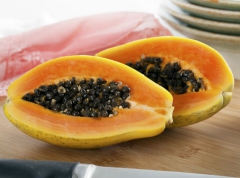02/04/2015
Babies made-in-India - 2. Abstinence
 In order not to have children without using a birth control, there is also abstinence... Forced abstinence because sex before marriage is not allowed. Abstinence due to physical incompatibility of spouses who have not chosen each other. Or when woman are forced to marry stray dogs (cf article)… The reasons are multiple.
In order not to have children without using a birth control, there is also abstinence... Forced abstinence because sex before marriage is not allowed. Abstinence due to physical incompatibility of spouses who have not chosen each other. Or when woman are forced to marry stray dogs (cf article)… The reasons are multiple.
To give an idea of the context, I would like to quote my Gynec and her theory on the benefits of episiotomy for Indian women [from middle and high class I presume].
My Gynec likes it very much, comparing Indian and Western people. For example, on the question of the weight (an obsession with her) she told me many times (every time I would climb on her weighing machine actually) that Indian women are genetically programmed to put on more weight than others. And since they think they should "eat for two" the weight gain can go far… Like over fifty kilos for my landlady who simply doubled her weight during pregnancy!
To go back to our main topic, to pass time while she was quietly stitching my vagina, she gave me her theory on the elasticity of the organ in question depending on the species. According to her, Indian girls are virgin when they get married. They get pregnant during the first intercourse, or quite rapidly, then stop indulging in this sinful activity during the nine months of pregnancy. So when they give birth, they are almost in the same state than Virgin Mary. So it hurts! And so it is better to cut a bit to be sure that the baby comes through...
(To be continued...)
08:00 Posted in Expatriation (in India and in other countries), Incredible India!, Little Samourai, My stories in India | Permalink | Comments (0) | Tags: india, birth, water birth, pregnancy, baby, infant, newborn, delivery, midwife, swaddling, swaddle, diaper, breastfeeding, hospital, fertility, contraception, sterilization | ![]() Facebook | |
Facebook | |
02/02/2015
Babies made-in-India - 1. Fertility & Contraception
For starters, a small overview of childbirth and culture(s) in India...
 At the beginning, I felt a little guilty of bringing into the world one more Indian (1): they are already so many... And they breed like rabbits, I thought! But not so much actually! The rabbits have seriously been controlling themselves in the past two decades...
At the beginning, I felt a little guilty of bringing into the world one more Indian (1): they are already so many... And they breed like rabbits, I thought! But not so much actually! The rabbits have seriously been controlling themselves in the past two decades...
Think of this: Indian women had 2.5 children each in 2012 – which is far from the 4.5 children they had just 20 years ago! (2) In fact the current rate is getting dangerously close to the minimum rate of 2.1 children per woman below which, without immigration and after a gap of thirty years, the population begins to decline.
Moreover almost all Indians I know have decided to have only one child because they want to "provide the best" for him and it is damn expensive to raise a child, with the education fares and all.
So how have they managed to change the trend? To start with, Indians have a radical enough, although controversial (because not always chosen freely) method: sterilization. And they don’t do things half way: 37% of married women are sterilized (for 1% of men)! Sterilization represents thus more than two-thirds of contraceptive means – and only one out of two couples today use a child birth control method.
There is a real lack of information: only 15% of the Indians between 15 and 24 have received some kind of sexual education. Not surprising when you know that the conservative parties (like the one currently running the country, whose leader (the Prime Minister) is incidentally not married lives without a female companion) have banned it in some States seven years ago, because sexual education would “give ideas to the youth”!
Among the (relatively few) couples who use a method of contraception that is not sterilization, the pill is not popular at all, even in cities – so that when I mention the pill to friends, it is common that they don’t know much about it. However, the i-pill is taking off quite fast; thanks to good marketing campaigns, girls swallow it as candy, ignoring (or choosing to ignore) its side effects.
(1) But in reality, technically, the baby is French since Indians do not recognize dual citizenship and a European passport has its charms... And he will have a PIO/OCI card, some sort of lifelong visa allowing him to buy and all.
(2) For reference, the French women have 2.0 children, the Chinese 1.7, the British and the American 1.9.
Sources: http://data.worldbank.org/indicator/SP.DYN.TFRT.IN; http://www.theglobalmail.org/feature/what-happens-when-half-the-world-stops-making-babies/573/; http://www.geocurrents.info/population-geography/indias-plummeting-birthrate-a-television-induced-transformation#ixzz3Q1R1nOej; http://www.bbc.com/news/world-asia-india-29999883; http://www.icmr.cami-health.org/articles/presentations/Session2-Speaker2-SKSikdar.pdf; http://world.time.com/2013/07/10/world-population-focus-on-India-part-1-sex-education/
(To be continued...)
08:00 Posted in Expatriation (in India and in other countries), Incredible India!, Little Samourai, My stories in India | Permalink | Comments (0) | Tags: india, birth, water birth, pregnancy, baby, infant, newborn, delivery, midwife, swaddling, swaddle, diaper, breastfeeding, hospital, fertility, contraception, sterilization | ![]() Facebook | |
Facebook | |
11/06/2014
Pregnancy advice, Indian style
At 6 weeks, my Indian gynaecologist (a dinosaur) confirmed the pregnancy and provided her first recommendations: “You immediately stop papaya. And also pineapple. Also you stop outside food for the next 6 weeks.”
 Not that I eat papaya everyday but I don’t like being told I can’t do things! So I checked… There was only a study, conducted on rats, and here is what is says: “The results suggest that normal consumption of ripe papaya during pregnancy may not pose any significant danger. However, the unripe or semi-ripe papaya (which contains high concentration of the latex that produces marked uterine contractions) could be unsafe in pregnancy.” (source). As my new doctor puts it, you need to it kilos of papaya to maybe feel an effect, nothing to panic about after eating a slice at breakfast!
Not that I eat papaya everyday but I don’t like being told I can’t do things! So I checked… There was only a study, conducted on rats, and here is what is says: “The results suggest that normal consumption of ripe papaya during pregnancy may not pose any significant danger. However, the unripe or semi-ripe papaya (which contains high concentration of the latex that produces marked uterine contractions) could be unsafe in pregnancy.” (source). As my new doctor puts it, you need to it kilos of papaya to maybe feel an effect, nothing to panic about after eating a slice at breakfast!
 Then I informed my stock manager about the pregnancy and his first question was whether I had hanged a poster of cute babies on the wall? He was convinced of the method because he had hanged a poster of white babies and his daughter was of fair complexion! Careful not to have a Smurf pic on the wall!! When I laughed about it (in spite having seen a similar poster on my sister-in-law’s wall) I was told that having “having good looking or positive pictures on the wall can surely make me feel good which is great for overall pregnancy and well-being”. Later on, in the same vein, my favourite Indian asked me to read less thrillers and stop watching murder movies… Happy puppy will give birth to happy puppies!
Then I informed my stock manager about the pregnancy and his first question was whether I had hanged a poster of cute babies on the wall? He was convinced of the method because he had hanged a poster of white babies and his daughter was of fair complexion! Careful not to have a Smurf pic on the wall!! When I laughed about it (in spite having seen a similar poster on my sister-in-law’s wall) I was told that having “having good looking or positive pictures on the wall can surely make me feel good which is great for overall pregnancy and well-being”. Later on, in the same vein, my favourite Indian asked me to read less thrillers and stop watching murder movies… Happy puppy will give birth to happy puppies!
A few weeks later, I visited a customer and her reaction was very spontaneous: “Oh you look even more beautiful! When is your baby girl due??” Seeing my face – how could she possibly have an information (the gender) that I didn’t?? – she explained that a glow on the face indicates you will deliver a baby girl. But glowing me also has a low, small and round belly, which would indicate a boy. So let’s see!
At work, I also get “healthy” advice: “you need to eat double as you eat for two”, “don’t take the stairs it may create a shock for the baby”, “what??? You are traveling by rickshaw, stop immediately! And by bike also, are you nuts??”. No wonder a lot of pregnant Indian women turn into elephants – which is the favourite topic of my new gynaecologist: the wonder of Indian mothers’ transformation during pregnancy versus Western women – her theory is that it has to be genetic. Which I am not convinced about since studies (source) state that “women in Western Europe gain 10-12 kg in weight compared with their counterparts in the developing world [India being included in the study] where the average weight gain is 7-9 kg”. Anyhow, she still shows no compassion when I put on an extra 100 gms!
I was not given the following advice but I found it very funny: “Drinking coconut water after the seventh month of pregnancy makes the baby’s head as large as the coconut.” Or “eating something white first thing in the morning will result in a fair-skinned baby.”
And, last but not least, when discussing these Indian myth with a French friend, she shared, roaring with laughter, that she had read that in villages, pregnant women eat ghee (clarified butter (pure butterfat left over after the milk solids and water are removed from butter) commonly used in Indian cooking) to lubricate the way out of the baby. I also found it very funny till the day my favourite Indian came home with ‘my’ ghee. And no, I didn’t laugh at his face because when he came home in the first trimester with my ‘tea’ (a disgusting ayurvedic potion called ‘Bhadradi Kashayam’) he practically saved my life and helped me overcome nausea all through the pregnancy. Plus he had taken up on him to give me a healthy diet and made salads, soups, juice etc. every day. So the minimum I could do was to take him seriously and do some research. I was not supposed to eat cooking ghee but a special ‘herbal’ ghee, like he has one for his joints (depending on the herbs, the ghee will deposit in different parts of the body). And not astronomical quantities like I had been told (which was to ruin all our efforts for me not to put on too much weight). So I have been taking one spoon daily of ‘Sukhaprasava Ghritham’. It is given in 7th and 8th month of pregnancy to ensure easy delivery of child.
Sources (pregnancy myths in India): http://www.babycenter.in/x1023025/is-it-safe-to-eat-papaya-ipapitai-during-pregnancy ;
http://www.thehealthsite.com/pregnancy/eating-ghee-will-make-your-baby-slide-out-easier-and-other-such-hilarious-indian-myths-busted/; http://wonderwoman.intoday.in/story/food-myths-in-pregnancy/1/84211.html ; http://www.rediff.com/getahead/2007/may/23preg.htm
Sources (Ayurveda and pregnancy): http://www.ayurvedaelements.com/articledivinedelivery.php ; http://ayurveda-foryou.com/women/garbhasanskar.html ; http://ayurmedinfo.com/2012/05/28/sukhaprasava-ghritham-benefits-dosage-side-effects-ingredients/
08:02 Posted in Expatriation (in India and in other countries), Incredible India!, Little Samourai, My stories in India | Permalink | Comments (0) | Tags: india, pregnancy, advice, myth, papaya, ghee | ![]() Facebook | |
Facebook | |















